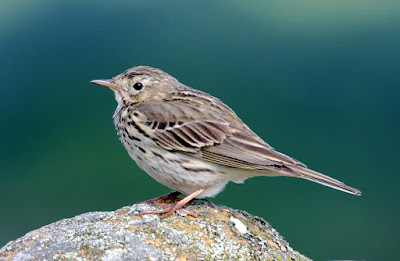Spring is barely over but already it seems that a few waders have left their breeding haunts. First back this morning at Conder Green – a Common Sandpiper. It’s a species which breeds up in the hills 15/20miles away and not in lowland Fylde. I heard it call as it flew behind and then over my head as it lost height, flicked over the pool, landed on the near island and then bobbed along looking for a meal. I glanced at the date on my watch. Bang on time, perhaps one or two days early for the annual excitement of spotting returning waders, the spick-and-span youngsters or the adults showing copious amounts of their summer plumage.
Common Sandpiper
It made me look at the local waders on show and not far behind the frontrunners - Oystercatchers with half grown young, 3 Pairs of Avocets with 3 youngsters on show, noisy complaining Redshanks, and a gang of Lapwings young and old.
I counted 20+ Redshanks without actually seeing any youngsters but the behaviour of adults told me that chicks were not too far away. Around here we’re sort of celebrating the Avocet success of recent years but as I watched their aggressive behaviour in chasing off godwits, Redshanks, Oystercatchers and Shelduck I wondered what the future holds here for other species now that the Avocets will return each year.
Avocet
Oystercatchers
Rather oddly, there are still 40 or more Black-tailed Godwits here that have been around for several weeks and who chose in recent days not to go north with many of their compatriots. I did note today that most of those left are second-summer rather than fully adult birds, a fact which explains their reluctance or lack of urgency to leave. The feeding here is very good. I watched the godwits take endless numbers of worms from the mud and then walk down to the water’s edge to dip and clean their prey before swallowing them whole.
Black-tailed Godwits
On the pool also: 15 Shelduck, 1 Little Grebe, 1 Grey Heron and 8 Tufted Duck. I watched as a male Tufted Duck slowly reassured the female that all was well to go back to her island nest. She climbed up the grassy bank, slipped through a tunnel of vegetation and was gone. The male floated off to join his mates. Tufted Duck incubation is up to 28 days so she can’t be far off leading her chicks into their brave new world; I hope they do better than last year’s brood of 10-12 which vanished in double quick time.
Near the bridge and main road were at least 3 singing Reed Warblers, 2 Reed Bunting, 2 Whitethroat and 2 Song Thrush. A Kestrel overhead hovered, hunted low and then flew off carrying food.
Kestrel































































.jpg)













